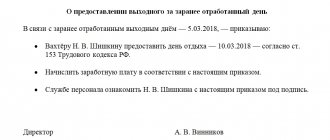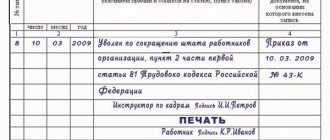Some data
According to the study, the question “How much severance do you pay to employees who are laid off due to staff reduction?” the answers were distributed as follows: 41.8% - in the amount of average earnings; 39.6% - have never made staff reductions; 12.5% - did not pay, asking the employee to resign of his own free will; 6.1% - in an increased amount.
Art. 81 of the Labor Code of the Russian Federation establishes the right of an employer to terminate an employment contract with employees if there is a reduction in the number of employees of the organization. To ensure the legality of dismissal, the employer must provide preferential rights to certain employees during layoffs (Article 179 of the Labor Code of the Russian Federation).
Categories of employees with preferential rights:
- Highly productive and qualified;
- Family – if there are more than 2 dependent persons;
- Those who received an industrial injury while working at this enterprise;
- Disabled people of the Second World War;
- Fathers raising one or more children without a mother;
- Pregnant employees, women with children under 3 years of age;
- Single mothers who are raising a disabled child;
- Workers whose family has no other income-generating members.
Compliance with the pre-emptive right when reducing staff is mandatory, since the issue of the legality of dismissal can be raised in court. An employee who believes that his layoff was unjustified has the right to file a lawsuit. The creation of a special commission and documents based on the results of its work argue for the employer’s position when considering the case.
Is it necessary to create a commission when reducing the number of employees?
If you plan to reduce staff, the total number of employees, without a special commission it is difficult to comply with the laws. But a situation is acceptable when the employer does not take such an initiative.
The Labor Code regulations do not contain precise instructions according to which the creation of a commission would be a mandatory requirement. Managers are given the right to make independent decisions about how and with which employees to terminate employment contracts.
In any case, the legality of each action taken requires separate verification. The creation of a commission helps to comply with the requirements of current regulations.
What is staff reduction like?
Personnel reduction has 2 options, leading to the following in the staffing table for all or individual departments:
- a staff unit (position) is eliminated, and this requires the reduction of all employees with such a position;
- The staffing unit (position) is retained, but with a decrease in the number of employees for this position.
In the first case, the staff is reduced, in the second - the number. Moreover, for both options it is possible to reduce not real people, but existing vacancies. And in both options, the number of persons subject to reduction may include those whose dismissal at the initiative of the employer is prohibited by law (Article 261 of the Labor Code of the Russian Federation):
- pregnant women;
- women who have a child under 3 years of age;
- persons raising a child under 14 years of age alone (18 years if the child is disabled);
- the sole breadwinners of a disabled child under 18 years of age or a child under 3 years of age in a large family with 3 or more young children.
When staff or vacancies are reduced, the employer does not have the problem of choosing between employees. But when reducing the number of employees occupying the same position, a choice must be made.
The main guideline when choosing should be higher labor productivity and qualifications of the employee (Article 179 of the Labor Code of the Russian Federation), however, there are grounds that give the employee an advantage over other employees with the same productivity and qualifications:
- the presence in his family of at least 2 dependents who are fully and permanently supported by him;
- absence of other workers in his family;
- injury or occupational disease received while working at the place where the layoff is taking place;
- the presence of a disability acquired while participating in hostilities to defend the USSR or the Russian Federation;
- advanced training in the direction of the employer without interrupting work.
Each reduction option (if it does not reduce vacancies) requires analysis of not only professional, but also personal information for each employee affected by the reduction.
What should be the composition of the commission?
The labor documentation of the Russian Federation does not contain information regarding what the composition will be. In this case, the employer also compiles a list of those taking part in the event. The optimal solution is when the commission is represented by the following employees:
- Lawyers . They involve consultations in the relevant field. This is all the more relevant when the dismissal of a citizen is related to controversial issues and situations.
- Representatives of the personnel service . Provide documentation with information regarding employees who are being laid off.
- Management in structural units whose work is affected by the reduction. They help provide adequate assessment when necessary for the training of subordinates and their skills.
- The employer or person entrusted to represent the interests. Act as chairman of the commission.
Composition and order of creation
A commission is created to dismiss workers due to reduction, by issuing an order by the head of the enterprise. The order is drawn up in free form. It reflects the participants of the meeting and the timing of the decision.
As a rule, it is issued simultaneously with the order to dismiss employees. The commission usually includes HR specialists, representatives of the trade union committee and lawyers. The director of the company is the chairman. The presence of the heads of the departments in which the reduction is expected is also required.
They have information about the achievements and qualifications of their subordinates, know their workload level, labor productivity, etc. Also, experts from third-party organizations may be involved to assess the personal and professional qualities of company employees.
The work of the commission is carried out on the basis of the following documents:
- personal files of company employees provided by the personnel department;
- documents on education and advanced training of each subordinate;
- results of certification completed during the period of employment;
- documents containing information about outstanding, unlifted disciplinary sanctions;
- personal characteristics of professional, personal and business qualities, drawn up by immediate managers or HR specialists;
- additional documents and information provided by the employee to exercise the preferential right to retain his job.
Execution of orders for the creation of commissions
When a positive decision is made to collect a commission, the first action on the part of the employer is to issue an appropriate order with information. The document becomes the main basis on which the commission meets.
The employer has the right to decide what the document will be, since there is no standardized form.
Table 1. Information in the order on the creation of the commission
| Order items | A comment |
| A cap | Contains the full form of the company name along with all details. Be sure to indicate the date the order was issued along with the serial number. It is mandatory to have references to legislative acts that regulate the reduction procedure. |
| Description of the purpose for which the commission is created | Here they indicate that an event has been organized to reduce the number of |
| Main part, in text form | Usually a list of members making up the commission is provided here. It is necessary to indicate positions, secretaries, chairmen, and so on. Specific actions and powers are indicated for commission members. |
| Indication of the person responsible for issuing the order | Usually this function is assigned to the head of the enterprise. |
| Signatures of responsible persons and seal of the organization |
Consideration of the decision at a meeting of the trade union meeting
The second part of Article No. 82 of the Russian Labor Code obliges the head of an enterprise, when planning a procedure for reducing staff or the number of employees, to take into account the opinion of the elected trade union committee.
This organization protects the labor rights of workers. After signing, the protocol, together with the order for layoffs, is sent to the chairman of the trade union organization. Specialists from this institution review the received documents and send the employer within a week a reasoned opinion regarding the dismissed employees.
Thus, when planning staff reductions, a special commission is created. It determines who to fire and who to keep working at the enterprise. The decision is documented in a protocol. Such a document is drawn up in free form at a meeting of the commission members. The signed protocol is sent to the trade union committee for consideration and expression of a reasoned opinion.
Dear readers, the information in the article may be out of date, take advantage of a free consultation by calling: Moscow +7
, St. Petersburg
+7 (812) 425-62-38
, Regions
8800-350-97-52
What responsibilities do members have?
The main purpose for which any commission is collected is to competently assess the level of current productivity of employees at risk. The case of each subordinate is considered individually. A general description of the responsibilities of members is as follows:
- preparation of relevant documentation in the form of decisions;
- making a decision on the need for dismissal;
- taking into account the personal qualities of the employee, along with professional training, level of qualifications, and the correspondence of knowledge to the work performed;
- identifying employees for whom layoffs are prohibited;
- studying the opinion of heads of structural divisions;
- comprehensive consideration of each candidate nominated for dismissal.
Selection of a candidate for dismissal
The procedure for carrying out reductions is regulated by such a legal act as the Labor Code of the Russian Federation. In accordance with the rules of Art. 179 of the Labor Code of the Russian Federation, the employer is obliged to:
- compare the quality of the employee’s work and the compliance of the specialist’s qualifications with the position held;
- if these qualities are the same for several employees, then the manager must pay attention to other circumstances determined by law or a collective agreement that give priority to the employee during layoffs.
The law does not establish in what form a manager must determine an employee’s candidacy for dismissal (individually or as part of a board) and record his choice. Preference is given to a collective decision and recording on paper due to the following circumstances:
- A lot of papers are subject to evaluation: documents on the appropriate level of qualifications, the results of the employee’s work, certificates containing personal data of the employee and his family members. If one of the commission members is engaged in providing such information, then the choice will be easier to make based on visual data.
- In case of litigation, the commission’s assessment of the employee’s suitability for the position will be more effective, since these parameters are not defined by law.
Rules for drawing up a protocol
A protocol is a written report that the commission draws up at one of the final stages of its work. The company's local regulatory documentation may contain information related to the execution of this act.
The main thing is that the protocol contains the following information:
- Signatures of responsible persons.
- The decision that was made in the end.
- List of issues considered during the meeting.
- Composition of the commission, with initials and positions.
- Details and conditions under which the procedure is organized.
- Name of paper.
Information is entered separately for each of the specialists affected by the case. If a subordinate has disciplinary sanctions, they are also taken into account. The same applies to practical work experience and professional achievements.
Step-by-step instruction
When carrying out the reduction procedure, the enterprise must comply with legal provisions in full. Otherwise, such dismissal may be considered unfounded.
Step 1. Issue an order
The procedure begins with the issuance of an order by the enterprise administration. It must indicate:
- reason for reduction;
- Job title;
- the date from which it is abolished;
- list of persons responsible for carrying out the reduction procedure.
Trade union committee in the process of layoffs
During the layoff procedure, subordinates become more vulnerable compared to employers. Therefore, taking into account the opinions of representatives of the trade union body has also become a mandatory requirement. Just one resolution of the assembled commission is not enough.
If a representative of this association was not invited to the event, the trade union has the right to hold its meeting. At this meeting, employers provide documents that become the basis for decision-making. If the trade union body has not given any response within the next seven days, the manager has the right not to take this opinion into account.
Persons subject to dismissal must receive offers of employment for other vacant positions associated with the same enterprise. If an employee believes that the dismissal is illegal, he has the right to appeal the decision, but in court.
Compilation algorithm
Any complex situation can be explained through a simplified life event - a model, which usually serves as an example. So we, having presented a situation, will draw information from it to draw up a protocol - one that is provided for by law.
Example . Due to the current market situation, Passage OJSC (Moscow) is forced to reduce the volume of work.
Because of this, the number of couriers involved in the organization’s forwarding department is subject to reduction.
There are 6 of them in total - Ivanov I.N., Stepanov L.T., Stroev P.P., Tikhonov G.D., Yudin M.A., Yusbashev A.V.
To decide which of them will leave the organization, a commission was assembled (04/20/2016), with the mandatory drawing up of a protocol afterward.
Through this example we will navigate the situation, but first let’s say what details the protocol – as a unified document – has . It consists of:
- name of the organization;
- indication of the type of document;
- dates, magazine numbers (on the same level, for convenience);
- meeting places;
- title;
- text;
- signatures.
This is the basis that should be in every protocol.
IMPORTANT . It is unlikely that visas will be approved, much less stamped on the protocol. This is due to the fact that the protocol is an intra-organizational document, which, as a rule, does not go beyond the boundaries of the enterprise.
Minutes of the staff reduction commission meeting: sample
- And this is a sample protocol on layoffs of specific employees.
We will not pay attention to every detail of the document, but will focus on what interests us. Let us dwell on the text of the document, which consists of the following parts.
Introductory part
This element is necessary to reflect the persons present at the meeting. Begins with the lowercase word "present".
REFERENCE . The chairman and secretary of the commission are persons who are nominated separately and are not included in the list of those present. This is due to their obligation to certify the final version of the document with their signatures.
Main
It concentrates the factual material of the commission.
It is composed of two elements - the agenda and, in fact, reports (messages) and speeches (proposals) .
Let's look at each in more detail:
- The agenda - the essential basis of any meeting of a collegial body - is concentrated in it. So, if we take an example, the agenda will be as follows (answers the question “about what?”), about reducing the number of couriers in the forwarding department.
- Reports and speeches. After announcing the reason for the meeting, reports and speeches follow one after another.
Reports or messages prepared in advance are reflected in the minutes with the capital word “listened to”. Here's some example data for illustration:- ...in connection with the above reports, the following are subject to reduction: Stepanov L.T., Tikhonov G.D., Yudin M.A., Yusbashev A.V....;
- speeches that were generated by discussions are recorded after the word “spoke” (also in words):
... Artemyev A.B., head of the personnel department, supported the candidates nominated during the discussion of reports and expressed agreement with the criteria for assessing the quality of their activities, corresponding to the standards of the Labor Code code...
Notifying employees about the commission's decision
The commission's decision must be made before the time comes to warn the subordinate about the severance of the employment relationship.
The legislator does not set a deadline for the employer to accept the verdict, but establishes it in Part 2 of Art. 180 of the Labor Code of the Russian Federation, a two-month period for notifying a specialist. If the employer does not transfer the document to the employee within 2 months, the layoff will be illegal. The message is drawn up on paper in the form of a separate document. The employee must sign and indicate the date of review. If the decision is made collectively, you can also familiarize the subordinate with the protocol against signature. In this case, an extract from the decision is given to you. The message is drawn up in two copies - for the specialist and the employer.
If the employee refuses to sign the document, it is sent by mail with a notification letter. The refusal should also be recorded in writing, with the participation of eyewitnesses from among the organization’s employees.
How to minimize risks when part of the team is forced to leave is described in the following story.
An example of calculating payment of monetary compensation in 2021 for staff reduction
Compensation is calculated using the following algorithm.
- Evgenia’s salary is 15 thousand rubles. per month.
- We determine the annual income: 15 * 12 = 180 thousand rubles.
- Divide by the number of working days per year: 180 / 248 = 0.726 thousand rubles.
- The resulting average daily earnings are multiplied by the number of days that Evgenia had to work in the month following her dismissal: 0.726 * 22 = 15,972 thousand rubles.
The calculation is carried out similarly for the second month after the reduction. The results are summarized.
Necessary grounds for staff reduction
There are three main reasons why an organization might downsize.
- Unfavorable economic conditions: this may be a market situation when the provision of services or the sale of goods of an enterprise is difficult due to external reasons. Consequently, it is necessary to reduce the volume of activity.
- Reorganization, merger, acquisition of companies: in the emerging company, a different staffing table is introduced, and for a number of positions there may not be room in it.
- Optimization of company activities: restructuring of production processes or the implementation of a cost reduction program may be the reason for the elimination of some positions in the staffing table.








